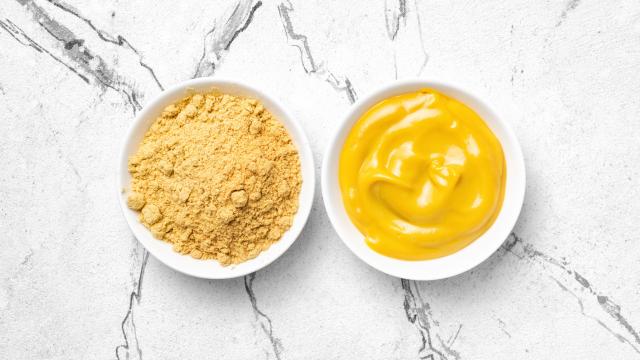If you ask someone what mustard “tastes like” they might tell you it’s both “pungent” and “acidic,” which is not quite right. This half-truth is sometimes perpetuated by well-meaning food writers, who tout mustard as “secret ingredient” that can cut through richness with its “acidity,” while claiming that “yellow, Dijon, grainy, and powdered mustards all work” the same way.
While it’s true that a bottle of prepared mustard — such as French’s — contains a fair amount of vinegar, mustard seeds and dry, powdered mustard aren’t acidic at all, because they don’t contain any acid. In fact, if you were making mustard with mustard powder, you could actually use vinegar (which contains acetic acid) to temper the mustard’s pungency, but we’ll get to that in a minute.
Dry mustard is a fairly misunderstood ingredient that exists in a realm in between whole seeds and prepared, liquid mustard. Sometimes called “mustard flour,” it’s made from ground seeds that have been sieved to remove the seed coat, resulting in a fairly yellow powder that sits there unobtrusively, waiting to be activated. Like wasabi, horseradish, and onions, mustard is another ingredient humans use to self-harm in a small, exhilarating way. Mustard tries to fight us off with tiny chemical warfare, but we are sick animals who like pain sometimes and are therefore not deterred. (Brand-wise, I’m a big fan of S&B, which contains a little turmeric, though Coleman’s is good, too.)
All it takes is a little moisture. In fact, if you add a little water (and nothing else) to mustard powder, you’ll end up with a super potent, sinus-clearing condiment that rivals wasabi. According to Harold McGee’s On Food and Cooking, you have to damage, then moisten mustard seeds to activate their defence mechanisms:
Dry mustard seeds and their powder are not pungent. Their pungency develops over the course of a few minutes or a few hours when the seeds are soaked in liquid and ground, or the preground seeds are simply moistened. The combination of moisture and cell damage revives the seeds’ enzymes and allows them to liberate the pungent compounds from their storage forms. Most prepared mustards are made with acidic liquids — vinegar, wine, fruit juices — which slow the enzymes, but also slow the disappearance of the pungent compounds as they gradually react with oxygen and other substances in the mix.
So there’s a lot going on. Water activates the enzymes, the enzymes liberate the pain molecules, and vinegar slows the rate at which the enzymes release the pain molecules, decreasing (put also prolonging) the pungency, but it’s not the only thing that can affect mustard’s flavour. According to Harold, heat also affects pungency, so timing has to be considered when adding dried mustard to a recipe:
Once the pungency has developed, cooking will drive off and modify the irritant molecules and so reduce the pungency, leaving behind a more generic cabbage-family aroma. Mustard is therefore usually added at the end of the cooking process.
[referenced id=”944823″ url=”https://www.lifehacker.com.au/2020/08/use-this-template-to-make-a-perfect-vinaigrette-every-time/” thumb=”https://www.gizmodo.com.au/wp-content/uploads/sites/4/2020/08/18/zzpzerdsuj0kvhwbvdko-300×169.png” title=”Use This Template to Make a Perfect Vinaigrette Every Time” excerpt=”A good vinaigrette should punch your tongue with a potent combination of salty, sweet, and acidic flavours. Err too much in one direction or another, and your salad will suffer. Making a great tasting vinaigrette isn’t hard, however, and using the template above (and below) can help you nail it…”]
So when should you use dried mustard? It depends on what you’re trying to achieve. If you want a super aggressive, painful condiment, mix the powder with an equal amount of water 10 minutes before you plan to consume it, then blast your palate into oblivion. (I just took a break from writing this to make some painful mustard, which I then used to make some painful deviled eggs.) You can also doctor your homemade mustard with a little vinegar or sugar (to temper the heat), or white pepper and other seasonings (for flavour).
Outside of making extremely good liquid mustard, dried mustard can be used in cooking, though the flavour will be much less pungent, and little nutty (or cabbage-y) depending on when you add it. If, for example, you’re making a batch of macaroni and cheese with a pound of cheese, don’t expect half a teaspoon of dry mustard to make it through 45 minutes in the oven with its pungency intact, and definitely don’t expect it to “cut through” all that cheese with “acidity.” If you want acidity, you can use a prepared mustard that contains vinegar, or you can add a splash of white wine vinegar. (Also, unlike Dijon and other stoneground mustards, dried mustard isn’t too great at emulsifying salad dressings, as all that helpful mucilage lives in the seed coat, which is sieved out of dried mustard.)
But even if the mustard’s pungency is dampened by cooking and other ingredients, that doesn’t mean it’s not worth adding. Dried mustard does add depth, a warm toastiness, and a slight amount of pungency. Just don’t expect it to “cut through” anything.

Leave a Reply
You must be logged in to post a comment.